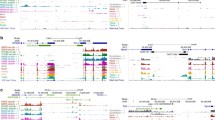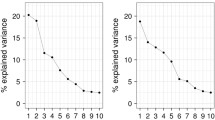Abstract
Careful manual annotation of the human reference sequence provides a solid basis for the identification of disease-associated genes. Toward this end, we focused on a medically relevant 2.6-Mb region of the human chromosome Xp11.4 between markers DXS9851 and DXS9751 and identified 16 transcription units according to the Vertebrate Genome Annotation (Vega) rules. In order to validate these annotations, we performed a comprehensive RT-PCR expression analysis and a human-mouse comparison. This revealed, despite the high overall genomic conservation of the region, remarkable differences of the gene content between human and mouse. Whereas 12 of 16 annotations were confirmed by RT-PCR in human tissues, for only seven genes mouse orthologs could be identified and found to be expressed. This indicates that a comprehensive and experimentally supported annotation effort of the human genome simultaneously highlights regions with striking differences in gene organization to other species and may indicate evolutionary events specific to the human lineage demanding further functional analyses.


Similar content being viewed by others
References
Abidi FE, Holinski-Feder E, Rittinger O, Kooy F, Lubs HA, et al. (2002) A novel 2 bp deletion in the TM4SF2 gene is associated with MRX58. J Med Genet 39: 430–433
Altschul SF, Gish W, Miller W, Myers EW, Lipman DJ (1990) Basic local alignment search tool. J Mol Biol 215: 403–410
Ansari-Lari MA, Oeltjen JC, Schwartz S, Zhang Z, Muzny DM, et al. (1998) Comparative sequence analysis of a gene-rich cluster at human chromosome 12p13 and its syntenic region in mouse chromosome 6. Genome Res 8: 29–40
Ashurst JL, Chen CK, Gilbert JG, Jekosch K, Keenan S, et al. (2005) The Vertebrate Genome Annotation (Vega) database. Nucleic Acids Res 33(database issue): D459–D465
Berti C, Fontanella B, Ferrentino R, Meroni G (2004) Mig12, a novel Opitz syndrome gene product partner, is expressed in the embryonic ventral midline and co-operates with Mid1 to bundle and stabilize microtubules. BMC Cell Biol 5: 9
Bonfield JK, Smith K, Staden R (1995) A new DNA sequence assembly program. Nucleic Acids Res 23: 4992–4999
C. elegans Sequencing Consortium (1998) Genome sequence of the nematode C. elegans: a platform for investigating biology. Science 282: 2012–2018
Chao KM, Zhang J, Ostell J, Miller W (1995) A local alignment tool for very long DNA sequences. Comput Appl Biosci 11: 147–153
Cox TC, Allen LR, Cox LL, Hopwood B, Goodwin B, et al. (2000) New mutations in MID1 provide support for loss of function as the cause of X-linked Opitz syndrome. Hum Mol Genet 9: 2553–2562
Demirci FY, Ramser J, White NJ, Rigatti BW, Meindl A, et al. (2003) Refinement of the physical location and the genomic characterization of the CRSP2 (EXLM1) gene on Xp11.4. DNA Seq 14: 123–127
Florea L, Hartzell G, Zhang Z, Rubin GM, Miller W (1998) A computer program for aligning a cDNA sequence with a genomic DNA sequence. Genome Res 8: 967–974
Gardiner-Garden M, Frommer M (1987) CpG islands in vertebrate genomes. J Mol Biol 196: 261–282
Gibbs RA, Weinstock GM, Metzker ML, Muzny DM, Sodergren EJ, et al. (2004) Genome sequence of the Brown Norway rat yields insights into mammalian evolution. Nature 428: 493–521
Gregory SG, Sekhon M, Schein J, Zhao S, Osoegawa K, et al. (2002) A physical map of the mouse genome. Nature 418: 743–750
Hardison RC, Oeltjen J, Miller W (1997) Long human-mouse sequence alignments reveal novel regulatory elements: a reason to sequence the mouse genome. Genome Res 7: 959–966
Holinski-Feder E, Chahrockh-Zadeh S, Rittinger O, Jedele KB, Gasteiger M, et al. (1999) Nonsyndromic X-linked mental retardation: mapping of MRX58 to the pericentromeric region. Am J Med Genet 86: 102–106
Horwich AL, Kraus JP, Williams K, Kalousek F, Konigsberg W, et al. (1983) Molecular cloning of the cDNA coding for rat ornithine transcarbamoylase. Proc Natl Acad Sci U S A 80: 4258–4262
International Human Genome Sequencing Consortium (2004) Finishing the euchromatic sequence of the human genome. Nature 431: 931–945
Kent WJ (2002) BLAT—the BLAST-like alignment tool. Genome Res 12: 656–664
Koop BF (1995) Human and rodent DNA sequence comparisons: a mosaic model of genomic evolution. Trends Genet 11: 367–371
Lewis BP, Green RE, Brenner SE (2003) Evidence for the widespread coupling of alternative splicing and nonsense-mediated mRNA decay in humans. Proc Natl Acad Sci U S A 100: 189–192
Mallon AM, Platzer M, Bate R, Gloeckner G, Botcherby MR, et al. (2000) Comparative genome sequence analysis of the Bpa/Str region in mouse and Man. Genome Res 10: 758–775
Ng D, Thakker N, Corcoran CM, Donnai D, Perveen R, et al. (2004) Oculofaciocardiodental and Lenz microphthalmia syndromes result from distinct classes of mutations in BCOR. Nat Genet 36: 411–416
Perry J, Feather S, Smith A, Palmer S, Ashworth A (1998) The human FXY gene is located within Xp22.3: implications for evolution of the mammalian X chromosome. Hum Mol Genet 7: 299–305
Ramser J, Abidi FE, Burckle CA, Lenski C, Toriello H, et al. (2005) A unique exonic splice enhancer mutation in a family with X-linked mental retardation and epilepsy points to a novel role of the renin receptor. Hum Mol Genet 14: 1019–1027
Robin NH, Feldman GJ, Aronson AL, Mitchell HF, Weksberg R, et al. (1995) Opitz syndrome is genetically heterogeneous, with one locus on Xp22, and a second locus on 22q11.2. Nat Genet 11: 459–461
Ross MT, Grafham DV, Coffey AJ, Scherer S, McLay K, et al. (2005) The DNA sequence of the human X chromosome. Nature 434: 325–337
Rozen R, Fox J, Fenton WA, Horwich AL, Rosenberg LE (1985) Gene deletion and restriction fragment length polymorphisms at the human ornithine transcarbamylase locus. Nature 313: 815–817
Schwartz S, Zhang Z, Frazer KA, Smit A, Riemer C, et al. (2000) PipMaker—a web server for aligning two genomic DNA sequences. Genome Res 10: 577–586
Searle SM, Gilbert J, Iyer V, Clamp M (2004) The otter annotation system. Genome Res 14: 963–970
Taudien S, Rump A, Platzer M, Drescher B, Schattevoy R, et al. (2000) RUMMAGE—a high-throughput sequence annotation system. Trends Genet 16: 519–520
Tsuchiya KD, Greally JM, Yi Y, Noel KP, Truong JP, et al. (2004) Comparative sequence and x–inactivation analyses of a domain of escape in human Xp11.2 and the conserved segment in mouse. Genome Res 14: 1275–1284
Tuchman M (1993) Mutations and polymorphisms in the human ornithine transcarbamylase gene. Hum Mutat 2: 174–178
Yanisch-Perron C, Vieira J, Messing J (1985) Improved M13 phage cloning vectors and host strains: nucleotide sequences of the M13mp18 and pUC19 vectors. Gene 33: 103–119
Zemni R, Bienvenu T, Vinet MC, Sefiani A, Carrie A, et al. (2000) A new gene involved in X-linked mental retardation identified by analysis of an X;2 balanced translocation. Nat Genet 24: 167–170
Acknowledgments
The authors thank Elke Meier, Petra Eißmann, and Kathleen Seitz for excellent technical help in DNA sequencing and RT-PCR. They are grateful to Michael B. Gorin and associates at the University of Pittsburgh for offering three BACs, to the Whitehead Institute for Biomedical Research/MIT and the Washington University Genome Sequencing Center for providing working draft data of four BACs, and the Sanger Centre Hinxton, UK, for the finished sequence of one BAC. This work was supported by the German Ministry for Research and Education (BMBF, German Human Genome Project grant 01KW9916 to MP and 01KW9974 to AM) and by a grant from the European community (EC, QLG2-CT-1999-00791) to AM.
Author information
Authors and Affiliations
Corresponding author
Electronic supplementary material
Rights and permissions
About this article
Cite this article
Wen, G., Ramser, J., Taudien, S. et al. Validation of mRNA/EST-based gene predictions in human Xp11.4 revealed differences to the organization of the orthologous mouse locus. Mamm Genome 16, 934–941 (2005). https://doi.org/10.1007/s00335-005-0090-3
Received:
Accepted:
Published:
Issue Date:
DOI: https://doi.org/10.1007/s00335-005-0090-3




